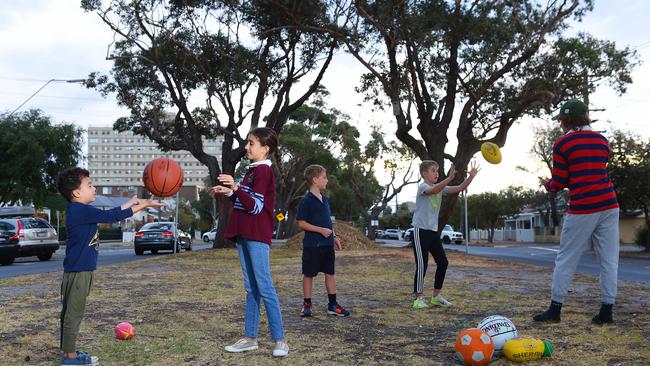Wildlife corridor trumps grassy play space on median strip in Albert Park
A play and picnic spot has been destroyed, families say, as an inner Melbourne council replaces grass with bark as part of a project to transform a median strip into an urban wildlife corridor.

Inner South
Don't miss out on the headlines from Inner South . Followed categories will be added to My News.
Angry families in Albert Park say Port Phillip Council has destroyed a family play and picnic spot.
The council is replacing the nature-strip grass on Danks St with bark but locals say they used the wide strip for games and get togethers and want the grass back.
“To have the grass removed is disappointing because we live in little boxes and hardly have any green around us,” father of two Bernard Mandile said.
THE TURKISH RESTAURANT IN BALACLAVA MAKING NIGELLA'S HEART SING
PUSH TO BRING LIVE MUSIC BACK TO ST. KILDA
DOG AND HUMAN TIMESHARE AT SOUTH MELBOURNE BEACH SCRAPPED
“It’s a waste of ratepayer money.”
The work is part of the Greening Port Phillip Strategy.
Mayor Dick Gross said the median strip between Pickles St and Mills St was being transformed into the city’s first formal urban wildlife corridor.

“When the project is completed by the end of May, more than 100 new native trees will have been planted alongside 600 indigenous plants and shrubs,” he said.
“Thirty-two nesting boxes will also have been installed for a variety of wildlife species, including lorikeets, rosellas and microbats.”
The council said the decision to remove the grass on the 1.15km long area was because a lot of it had died over summer.
Mr Mandile said the tan bark had already spilled onto the road in bad weather. Cr Gross said street cleaners would monitor the area.
Albert Park College, also on Danks St, will use the wildlife corridor.
The school’s environmental program co-ordinator Steven Stanecki said access to green spaces, particularly for kids learning in an urban environment, could help alleviate stress and anxiety.
“This wildlife corridor addresses the increasing concern of the prevalence of depression and anxiety in young people,” he said.


